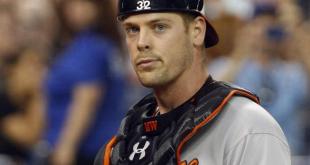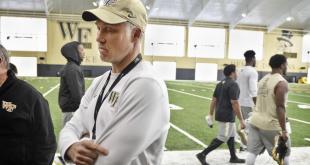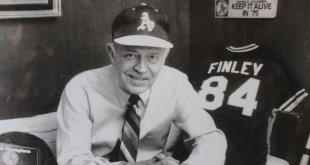This might prove to be a historic offseason as the Qualifying Offer[i] (QO) could be extended to a record number of players. If it weren’t for the high number of impending free agents changing teams before the trade deadline the potential number of Qualifying Offers would be even higher. The previous high for QOs extended was thirteen prior to the 2014 season. There is a chance that almost twenty Qualifying Offers could be extended this offseason, most likely to the following players:
| Player | Position | 2015 Club |
| Matt Wieters | C | Orioles |
| Chris Davis | 1B | Orioles |
| Howie Kendrick | 2B | Dodgers |
| Daniel Murphy | 2B | Mets |
| Ian Desmond | SS | Nationals |
| Alex Gordon* | OF | Royals |
| Colby Rasmus | OF | Astros |
| Justin Upton | OF | Padres |
| Dexter Fowler | OF | Cubs |
| Jason Heyward | OF | Cardinals |
| Wei-Yin Chen | SP | Orioles |
| Marco Estrada | SP | Blue Jays |
| Yovani Gallardo | SP | Rangers |
| Zack Greinke | SP | Dodgers |
| Hisashi Iwakuma | SP | Mariners |
| Ian Kennedy | SP | Padres |
| John Lackey | SP | Cardinals |
| Jeff Samardzija | SP | White Sox |
| Jordan Zimmermann | SP | Nationals |
| *Provided player option declined | ||
The players listed in red above are less likely than the rest of the list to receive a Qualifying Offer either because of their performance or positional value. However, given how the free agent market for players tied to a Qualifying Offer developed in previous years, clubs should extend QOs more liberally. Free agents extended a Qualifying Offer almost always signed elsewhere netting their club an early round draft choice if they didn’t re-sign with the original club.[ii] In its short existence, the Qualifying Offer has accomplished its intended goals – to compensate clubs for losing key players to free agency, and to function as a cost control measure by limiting salaries on the open market.
With last year as an exception, in two of the Qualifying Offer’s first three years, clubs’ extension of a QO has notably affected the demand for certain players on the free agent market. Prior to the 2013 season, Michael Bourn and Kyle Lohse each received Qualifying Offers and were unable to sign contracts with new teams until very late in the off-season, and those contracts were arguably below market value. In addition, Adam LaRoche returned to the Nationals on only a two-year contract after having a borderline MVP season.
Before the 2014 season almost 25% of the free agents tied to Qualifying Offers were negatively impacted. Stephen Drew and Kendrys Morales didn’t sign one-year deals until June, and Nelson Cruz joined the Orioles for far less than the value of the Qualifying Offer.[iii] Both Drew and Morales had a poor 2014 season and had limited suitors on the free agent market in 2015. As there is always a demand for established veteran players, if a club with limited payroll flexibility extends a QO that is accepted, that club should receive some return for that player[iv] – which is more than they would receive had he reached free agency without receiving a Qualifying Offer.
On the flipside, no player has ever accepted a Qualifying Offer. That should change this offseason. The MLBPA historically is the most unified of all professional sports unions. Numerous player strikes led to the financial success, growth, and security the players have enjoyed over the last two decades. So it wouldn’t be a shock to see players make individual sacrifices for a combined benefit. With guaranteed salaries, it is generally in a player’s best interest to seek a multi-year contract and forego a one-year contract with a higher average annual value.
Last year, Matt Swartz showed that Major League salaries are lagging behind baseball generated revenue despite each team receiving $25 million more annually from new national television contracts. Major League Baseball announced that the value of Qualifying Offers for the 2016 season was $15.8 million, an increase of $550K from the 2015 season, and the smallest since the Qualifying Offer was adopted. This could indicate that the average of the top-tier of Major League salaries is beginning to plateau and further the contention that general salary growth is slowing.
Qualifying Offer Value
| 2013 | 2014 | 2015 | 2016 |
| $13.3 | $14.1 | $15.3 | $15.8 |
As a result, some players might disregard the security of a multi-year contract to continue the push of increasing players’ salaries in future years – especially for certain positions that are undervalued. This selfless act would not only net them a larger salary for 2016, but also increase the value of the Qualifying Offer in 2017 – which may give teams pause before extending future Qualifying Offers. If some players accepted the Qualifying Offer in 2016 instead of negotiating a long-term contract with a lower Average Annual Value (AAV), then the average of the top 125 salaries for 2017 would be larger, leading to a higher Qualifying Offer in 2017. Players who could (and should) conceivably accept a Qualifying Offer are discussed below:
Matt Wieters
Only two catchers will earn salaries greater than the $15.8 Qualifying Offer and both those players, Buster Posey and Brian McCann, maintain offensive oriented profiles. Last season Russell Martin, a complete catcher with an exceptional defensive reputation, secured a five-year contract with an AAV of $16.4 million after a career offensive year helped carry a young Pirates pitching staff to the playoffs. As a stout defensive catcher Matt Wieters is comparable to Martin; however, Wieters only produced one season with an OPS above .800 (during his injury shortened 2014 season in which he only had 112 plate appearances). Wieters suffered a torn UCL requiring season ending surgery that also shortened his 2015 season and limited him to 55 games behind the plate once he returned to the active roster. During his limited 2015 season, Wieters was below the league average in caught stealing percentage for the first time since his rookie season, and only produced middling offensive numbers. He only produced a .267 batting average, an on-base percentage of .319 which is the second lowest of his career, and a slugging percentage of .422. Wieters might be best served taking the one-year QO with the hope that a bounce back 2016 season restores his free agent value prior to the 2017 season.
Second Basemen – Daniel Murphy & Howie Kendrick
Historically second basemen don’t receive large free agent contracts unless they put up great power number. Robinson Cano is the only second baseman with a scheduled salary above the Qualifying Offer in 2016, and only Cano and Ian Kinsler earned that much during the 2015 season. Besides Kinsler and Cano, other second basemen previously receiving major contracts covering their initial free agent years include Brandon Phillips, Chase Utley, and Aaron Hill. These players all recorded multiple twenty home run seasons or multiple seasons with an OPS above .800.
Daniel Murphy certainly helped his free agent value with his historic home run streak, hitting home runs in six consecutive games. Since there is usually a team willing to shell out major dollars for a free agent after a meteoric playoff performance, the Mets will most likely tender Murphy a Qualifying Offer.[v] However, Murphy has only logged one season with an OPS above .800 and has hit double digit home runs only three times – maxing out fourteen in 2015. Murphy’s defensive limitations – as a second baseman he has never posted a positive Defensive Runs Saved metric (DRS) and only one positive Ultimate Zone Rating[vi] (UZR) in his rookie year – were on display during the World Series as he committed two errors. Even with Murphy’s ability to play multiple infield positions, the presence of second baseman and utility-man extraordinaire Ben Zobrist on the open market (who isn’t tied to a Qualifying Offer) should limit the demand for Murphy. Unless a team is blown away by Murphy’s performance in the NLDS and NLCS, the average annual value of a Qualifying Offer from the Mets could be higher than the offers Murphy gets on the open market.
Howie Kendrick’s value is not necessarily recorded in the box score, but he plays above average baseball in every facet of the game. Kendrick’s workmanlike, steady, and dependable approach is evidenced through the 28.6 Wins Above Replacement (WAR) he’s put up in eight and a half years of Major League service time – putting him near an all-star caliber level when annualized. He has been a good defender, finishing only two seasons with a negative UZR and accumulating a positive DRS over the course of his career. However, Kendrick has never hit twenty home runs in a season and recorded only one season with an OPS above .800. His clubhouse presence and leadership is well documented, but his deficient power numbers should make the value of the Qualifying Offer an enticing proposition. Similar to Daniel Murphy, the presence of an unrestrained Ben Zobrist in free agency will likely limit the demand for other second basemen this offseason, so Kendrick might be best suited to accept a QO and arguably be the top second baseman on the market in 2017.
Starting Pitching – Yovani Gallardo & Ian Kennedy
The overabundance of starting pitching in free agency this year is likely to be the main issue faced by these pitchers. In addition to the players listed above, David Price, Johnny Cueto, Mat Latos, Mike Leake, and Scott Kazmir will hit the open market. If Yovani Gallardo or Ian Kennedy decline a Qualifying Offer they most likely will face a similar situation Kyle Lohse found himself in 2012 when he signed for only $33 million over three years at the end of Spring Training. Even worse, they might have to settle for a one-year contract less than the qualifying offer or not sign until after Opening Day.
Gallardo and Kennedy are both above-average pitchers who have shown glimpses of greatness. Yovani Gallardo hasn’t thrown over 200 innings since 2012 and his strikeout-to-walk ratio (5.9/3.3) in 2015 was the worst of his career. His strikeout rate has been in steady decline since his All-Star appearance in 2010, and although he finished the season with a 3.42 ERA, he also finished with the highest WHIP (Walks plus Hits/Innings Pitched) of his career which contributed to the ERA estimator Fielding Independent Pitching (FIP) pegging him for an ERA of 4.00.
Similarly, Ian Kennedy has only produced one season with a WHIP below 1.2 and has produced only one campaign with a sub 4.00 ERA since 2012. Last season Kennedy averaged less than 5.2 innings per start, gave up 1.7 home runs for every nine innings pitched despite making his home starts in spacious Petco Park, and finished the year with a 4.28 ERA. His struggles in 2015 are much more likely to affect his free agent stock than the 2011 season where Kennedy finished fourth in Cy Young voting.
Considering the amount of starting pitching on the free agent market it would be shocking to see either one of these pitchers sign a long-term contract with an AAV close to the value of the Qualifying Offer. Their best bet might be to wait it out until the starting pitching market thins next offseason.
No player has ever accepted a Qualifying Offer, but with the high number of available starting pitchers, players coming off injury, and players at devalued positions hitting free agency, this could be the year that changes. The relatively low increase to the value of this year’s Qualifying Offer as well as the shear volume of players receiving such an offer could inevitably impact free agency in 2017 and beyond.[vii]
[i] A Qualifying Offer is mechanism of MLB’s Basic Agreement whereby teams can offer 1-year contracts to impending free agents who have been on their roster for the entire preceding season. The value of the contract is determined by averaging the highest 125 salaries across MLB. This year clubs have until November 6th to extend a QO and players have until November 13th to accept the offer.
[ii] 74% of players signed a contract with a new club and 21% returned to their team prior to the season. Two players, Stephen Drew and Kendrys Morales, saw the Qualifying Offer effect the market for their services to such an extent that they didn’t sign a contract until after Opening Day.
[iii] $8 Million versus $14.1 Million.
[iv] Either through a midseason trade (players accepting a Qualifying Offer have a de facto No-trade clause through mid-June) or that player’s contributions on the field. If a player accepting a QO consents to a trade from his low-revenue team that club should still receive something – even a minor prospect – in return which is better than losing that player to free agency and receiving no recompense.
[v] Two quick examples – Carlos Beltran signed with the Mets for $119MM over 7 years in 2004 and Pablo Sandoval signed with the Red Sox for $95MM over 5 years in 2014.
[vi] Two leading sabermetric statistics to evaluate fielding. Ultimate Zone Rating (UZR) judges how many outs a player recorded relative to the balls hit to his position and others player’s ability to do the same. Defensive Runs Saved (DRS) functions similarly and rates players on how many runs there defense prevents with 0 being an average defender who grades out neutrally.
[vii] For more information, check out previous analysis by the Sports Esquires on the Qualifying Offer in 2013 and 2014.
 The Sports Esquires Putting Sports on Trial
The Sports Esquires Putting Sports on Trial





